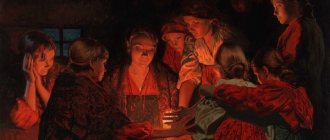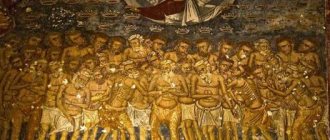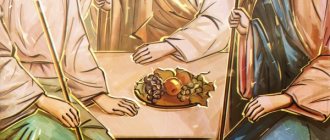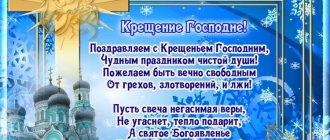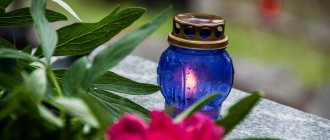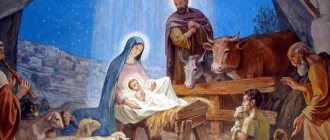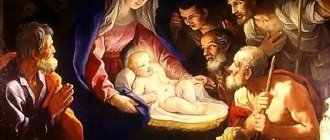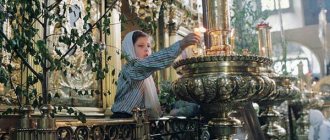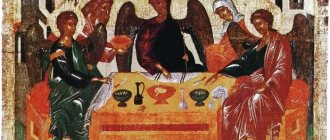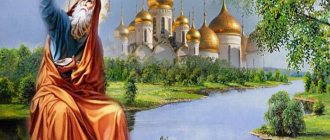Epiphany Christmas Eve is celebrated on January 18 (according to the old style - January 5). It ends the Christmas holiday period. On this day, the main preparations for Epiphany are made. January 18 is a day of strict fasting. The last day of caroling, the last Christmas fortune-telling. At Epiphany, snow is collected, which is believed to have special healing properties and keeps the water in the wells fresh throughout the year. Other names of the holiday: “Epiphany Evening”, “Hungry Evening”, “Water Carol”, “Second Christmas Eve”.
Photos from open sources/Internet
The essence of the holiday
Epiphany Christmas Eve (sochevnik) is the popular name for the day on the eve of the Epiphany holiday, coming from the word “sochivo” - a Lenten dish that believers eat on this day. Sochivo is boiled wheat grains seasoned with honey, dried fruits and other sweets. In church tradition, this time is called the Eve (that is, the threshold) of the Baptism of the Lord, or the Eve of Epiphany.
Epiphany Christmas Eve is an evening of preparation before the great Orthodox holiday called Epiphany. This holiday of the Orthodox Church belongs to the twelfth. On this day, the baptism of Jesus Christ by John the Baptist (Baptist) in the Jordan River is remembered. The Epiphany itself is one of the main holidays of the Orthodox Church and is celebrated on January 19 (according to the old style - January 6).
Due to the importance of the event that took place on the coming day in the life of Jesus Christ, the church established a fast. This is where the tradition of cooking sochivo came from; it is not mandatory, but has taken root everywhere. On this day, as on Christmas Eve, they do not eat food until the candle is taken out after the liturgy in the morning and the first communion of Epiphany water is taken.
On January 18, a large service is held in churches, similar to those held on Christmas Eve and Holy Saturday. All liturgical texts are dedicated to the Epiphany and Epiphany. The liturgy on this day begins with Great Vespers - this is a type of liturgy that is celebrated only a few times a year. We are talking about such church holidays as Christmas Eve, Epiphany Eve, Maundy Thursday and Holy Saturday.
On Christmas Eve, after the liturgy, the great consecration of water takes place in churches. So it is called because of the special solemnity of the ritual, imbued with the memory of the gospel event, which became not only the prototype of the mysterious washing of sins, but also the actual consecration of all the water in the world after Jesus Christ was immersed in it. This water is called agiasma, or simply Epiphany water. Under the influence of the Jerusalem Charter, from the 11th-12th centuries, the blessing of water takes place twice - both on Epiphany Eve and directly on the feast of Epiphany. Consecration on both days takes place in the same manner, so the water blessed on these days is no different.
There is a tradition of sprinkling your home with Epiphany water on this day while singing the troparion of Epiphany. Epiphany water is consumed on an empty stomach in small quantities all year round, usually together with a piece of prosphora.
Photo: tuapsevesti.ru
What icons should be in the house?
Every believer should have icons in their home. They should be located in the eastern part of the house. In a modern home, the eastern corner may be inconvenient for prayer, so it is allowed to place icons in other places.
Every home should have icons with the image of Jesus Christ, with the face of the Mother of God and St. Nicholas the Pleasant.
- The icon of Jesus Christ should be in a place of honor. She heals the sick, calms and pacifies. Protects from troubles and misfortunes, admonishes the lost. Supports, shows the right path.
- The Virgin Mary, Mother of God, helps women. They ask her for peace and harmony in the house, health for her family and children. She is the patroness of every woman. The Mother of God gives love and peace. She forgives and teaches patience and humility.
- Nikolai Ugodnik solves all problems and hardships. On special occasions, people turn to him for the healing of seriously ill people.
On Christmas Eve, the corner with icons is thoroughly cleaned. All dust must be thoroughly cleaned. Clean candlesticks from wax and replace candles. Place a clean napkin under the icons. You need to carefully monitor the iconostasis, but older people may not be able to do this well, so you need to come to such relatives or neighbors and put things in order. They, too, should celebrate the holiday in cleanliness and comfort.
Traditions
The ritual meal on Epiphany Eve took place according to the customs of “kolyadnye” (festive Christmas Eve) dinners. An odd number of Lenten dishes were prepared. The Eastern Slavs necessarily cooked kutya, dishes made from peas or beans, uzvar from dried fruits, and baked pancakes and bread products. At dinner, some Christmas customs were repeated: they invited “frost” (“the wolf”, “birds”, “animals” and other characters) to dinner; they threw the first spoon of kutya to the ceiling; they lit a candle “for the dead”; They set aside a portion from each dish for the souls of their ancestors.
To see the Baptism of the Lord, they put a bowl of water and watched whether the water swayed at midnight. If at midnight the water swayed, they ran to see the “open heavens.” At the same time they said: “If you see the flashes, at least ask for the kingdom of heaven. Everything will come true." At midnight they went to the river, spring, or well to draw water, which was attributed with healing properties and which was carefully protected. Even old men and young women went to dig snow in the open fields. Red girls washed themselves with snow water in the morning on the day of Epiphany, so that “without whitening they would be white, without blush they would be ruddy.”
The snow of this Christmas Eve was considered healing, they said about it: “mix it into the feed - the cattle will not be chilly; rash to the chickens - they will lay eggs. A snow bath adds beauty and drives away illness from the body. It’s also good for whitening canvases.” This snow was used to treat ailments - numbness in the legs, dizziness, cramps. Epiphany water was sprinkled on the hives during the gathering of swarms. Collected outside the outskirts (behind the village), in the field, they poured it into the well. This was done so that the water in the well would always be abundant and would never rot.
They put different types of grain in cups overnight, and in the morning they examined which grain had frost on it: “that’s the one who will be born this year.” The festive dinner on Epiphany Christmas Eve was called “hungry kutya”. The obligatory dishes of this meal were kutia, pancakes, and oatmeal jelly. On Epiphany night, young people spent their last Christmas party with songs, fortune-telling and other entertainment.
From the straw that lay under the tablecloth during dinner on Christmas Eve, they made overhang and tied fruit trees so that they would bear fruit better. In Polesie, during the Water Carol, the owner walked barefoot into the garden in the evening and tied up the trees so that “they would not be afraid of the frost,” saying: “I came barefoot, not afraid of the frost, and you should not be afraid.”
Christmas time was coming to an end, and with it terrible evenings, when evil spirits were playing tricks. To get rid of evil spirits, on the night of Epiphany on the eve of Epiphany, a crowd of young guys on horseback rushed through all the courtyards, beat with brooms and whips in all the dark corners and crannies with spells, screaming and screeching. In addition to this, crosses were drawn with chalk or charcoal on doorposts, on the lintel, and on the doors of barns, barns, and mills. The werewolf “Fire Serpent” was especially dangerous on Epiphany night, appearing to girls in the form of a handsome young man.
How long is Epiphany water stored?
If the water collected on the night of the Epiphany is kept away from human eyes and empty conversations - in a quiet and dark place - (believers keep it near the home iconostasis), then it retains its healing properties all year round. Epiphany water stored in glass containers can be used for a year or even longer.
This is a very strong energy water, so drinking it constantly is not recommended.
But if you are unwell, take it as a medicine, add it to the bath (from one teaspoon to one glass per bath), rinse your mouth, wash your face, spray your face, eyes, whole body - it is very useful. I remind you: there is no need to dry yourself.
It is better to store Epiphany water in a dark, quiet place. It is believed that holy water does not spoil, so there is no need to put it in the refrigerator.
Orthodox Christians keep it in the Red Corner next to the icons. In addition, a drop of shrine sanctifies the sea. You can take ordinary, unconsecrated water and add a drop of Epiphany water to it, and it will all be sanctified.
Epiphany water is best stored in glass containers.
From time to time, water is poured from a bottle or three-liter jar into a smaller bottle for use.
It is believed that you should not open the water container too often or keep it open. You should not keep Epiphany water in open buckets and pans for a long time. The water in ponds and rivers also soon after Epiphany night becomes the same.
And if in the future for some reason you want to pour this water, then under no circumstances pour it into the toilet or sink. Dilute with plain water and then pour or water the plants (by the way, it has been noted that undiluted Epiphany water has different effects on plants: some bloom, others, on the contrary, die. Therefore, it is better not to take risks and act carefully).
Prohibitions
It is forbidden:
- swear and use foul language;
- just get angry;
- place an even number of dishes on the table;
- think about bad things or simply think badly about someone while you are collecting consecrated water or water that you are just about to consecrate;
- eat meat and drink alcohol, even use vegetable oil when cooking - strict fasting on January 18;
- overeating during a holiday dinner.
Photos from open sources/Internet
Fortune telling
Since time immemorial, on the eve of Epiphany in Rus', fortune-telling has been widely practiced: for the groom, for a prophetic dream, for wealth, and so on. It is important to note that fortune telling in Orthodoxy is prohibited and is equated to witchcraft. For this reason, immediately after the ceremony, people doused themselves with holy water or dived into an ice hole to wash away their sin.
Young girls first of all wondered about marriage. To do this, the girls took apples and carved the initials of their boyfriends on them, after which they put them in a bowl and turned off the light. After thoroughly mixing the apples, the girls took a bite from each and chose the sweetest. The one whose name was carved on the most delicious apple was the future groom.
The means for fortune telling were objects in which, according to legend, magical power was concentrated. It could be a shoe, a skirt, a belt, a stocking, a thimble, a needle, a ring, a comb, a mirror. When doing fortune telling, the girl had to meet certain conditions by choosing the right place and time. But first of all, the girl had to leave the protection of her religion and amulets. Christian women, for example, took off the cross, and without exception, regardless of religion, they untied all kinds of knots on themselves, including belts, let down their hair, and sometimes took off all their clothes, including shoes.
To protect herself from otherworldly forces, the girl drew a magic circle around herself - with a candle or a torch, a knife, a poker. If they were telling fortunes in a group, the girls stood in a circle, holding each other's little fingers.
One had to go to the place of fortune-telling in silence, in the dark, trying to remain unnoticed. A special place for fortune telling was also chosen - “unclean”. This could be either an abandoned house, as well as a barn or canopy, a basement or attic, sometimes even a cemetery, or “border” places - those where two worlds form a border: a threshold or corner of a house, a gate, a crossroads, places near water (wells, cut through). They told fortunes in houses, they also told fortunes near churches.
Since ancient times, the crossroads have been considered an unclean place that belongs to demons; they said that at the crossroads an unclean spirit has power over a person. This place is the “border” between two worlds; both dangerous and, conversely, healing actions were performed here. The gate, which also served as a place for fortune telling, is a symbol of the border between one’s world and someone else’s. The girls would throw their shoes over the gate, standing at the gate, make a guess as to who would pass by (the appearance of a man foreshadowed an imminent marriage), climb onto the gate and “call out for share,” guessing their future from the sounds and voices they heard.
Fortune telling at the crossroads
At exactly midnight, come to the crossroads to “listen to the neighborhood.” Cheerful laughter or singing nearby means quick marriage and fun. If you hear crying or lamentations, there will be no wedding this year. It is believed that it is at the crossroads that you can hear the voice of fate, because here is the border between two worlds, and, standing at the crossroads, it is as if you are in two worlds at the same time.
Fortune telling on the mirror and the month
On one of the Christmas nights, when the month is visible in the sky, take a small mirror, go to the window and point the mirror so that the month is reflected in it. Look closely - after a while, instead of one month, you will see several. Count how many months you imagined: this is how the girls wondered about their future family - whether it would be big or not.
Fortune telling with three mirrors
For this fortune telling you will need three mirrors of approximately the same size and two tall candles. They begin such fortune-telling at midnight, having first outlined themselves in a magic circle - a sign of protection (drawn with chalk, a burning torch, and a candle).
Place two mirrors, one opposite the other on each side of you, light candles in front of them, and place the third behind them. You should see a reflection from the third mirror in the side mirrors, from where your betrothed should appear from the looking glass behind you.
Under no circumstances should you turn around or look at the figure in the mirror for too long. If the vision is frightening, say three times: “Forget me!” - and stop fortune telling by extinguishing the candles.
Fortune telling with matches
Insert two matches into the sides of the matchbox and light it. If the burnt heads turned towards each other, it means that the “given” guy and girl will be together.
Fortune telling by strings
Cut the threads to equal lengths and set them on fire. Whoever's thread burns out faster will be the first to be married. If less than half of the thread burns out or the thread goes out immediately, then you won’t get married this year.
Wealth or poverty
Quickly immerse the lit splinter into the water. If it goes out immediately, it means a poor life is expected, and if the fire goes higher, a rich life is expected.
Fortune telling by cat's paw
Make a wish and call the cat. If she crosses the threshold of the room with her left paw, it means her wish will come true. If right - alas! - No.
Royal dream
Place four kings from a deck of cards under your pillow and say a request-spell: “Who is my betrothed, who is my mummer, appear in my dreams!” The betrothed-mummer must definitely dream about it - in the image of a king - with a crown on his head and in a royal robe.
When and how to properly collect Epiphany water
Prepare glass containers with lids, such as 3-liter jars or bottles. Sterilize them thoroughly. In the Temple, holy water is also collected in very clean containers. You shouldn’t be blasphemous and take vodka or beer bottles for this, especially if there are still labels on them.
After 0 hours 10 minutes, fill this container with water from a well, spring or other clean source. You can just do it from the tap. It is advisable to pass it through a cleaning filter, but this is not a prerequisite. Fill the water and close the jars with lids.
Signs
- Heavy snow on the evening before Epiphany means a good grain harvest.
- A strong snowstorm means a good harvest.
- If snow falls on Epiphany Eve, then the whole year will be fruitful.
- What the weather is like on this day, this is what it will be like on Maslenitsa.
- If there is little snow on the trees, there will be very few or no berries.
- If there is a lot of snow and it bends the branches of the trees, this means a rich harvest.
- If there is a lot of snow on the trees, there will be a lot of honey.
- Little snow means there will be few berries and mushrooms in the forest.
Prepared based on information from open sources
Ritual for the fulfillment of a wish on Epiphany Christmas Eve
Before going to bed, pray to the Lord, read prayers for the coming sleep. Then write your deepest desires on pieces of paper, one desire on each piece of paper. Roll the leaves into a tube and place them under your pillow.
When you wake up in the morning, take one of the leaves out from under your pillow. Whatever wish was written there will be fulfilled within a year. However, you cannot make obviously unfulfillable wishes; for them you can receive punishment from above.
When your wish comes true, do not forget to thank God for his mercy. Go to church, light candles for your favorite icons and order a thanksgiving prayer service.
